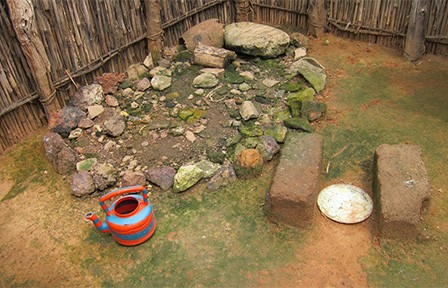Making Markets and Technology Work to Increase Access to Sanitation Facilities and Services in Senegal
By Aaron Brownell, Acting Economic Growth Office Director, USAID/Senegal

Given the extremely high prevalence of diarrheal disease in Senegal, progress in the water supply and sanitation (WSS) sector has significant importance to decreasing morbidity and mortality, particularly in children under five years of age. Diarrheal related illnesses are the second leading cause of death for children under five and account for about 40,000 preventable deaths each year.
In 1996, the Government of Senegal began reforming its WSS sector and, since then, it has made substantial improvements in coverage and sector organization. In 2005, Senegal developed a programmatic approach to coordinate WSS stakeholders called Programme d’Eau Potable et d’Assainissement du Millénaire (PEPAM) or the Millennium Potable Water and Sanitation Program. PEPAM has been instrumental in setting Senegal’s progressive WSS sector policy and investment program to put it on track to meet its Millennium Development Goal targets for water by 2015, with lesser prospects for sanitation.
Under the umbrella of PEPAM, there are a plethora of WSS programs that include rural sanitation activities. These programs implement a variety of approaches that apply different subsidy levels, technology options, and levels of community involvement and often work with the national and local government in different ways.
Despite significant investments in the sector, in an 18 year period Senegal has made modest gains toward the Millennium Development Goal targets in rural sanitation—moving from just 22 percent of the population in 1990 to 38 percent of the population in 2008 with access to improved sanitation facilities. To move from 38 percent to the Millennium Development Goal target of 59 percent in 2015 would require an estimated 1,540,015 additional people with access to an improved sanitation facility (approximately 154,002 additional latrines). Looking at the trends, reaching this goal seems unlikely if the WSS sector continues with the same approaches.
For rural areas—where 70 percent of the people without improved sanitation live—current approaches in the sanitation sector can include high subsidies (that are often not strategically implemented) to extend high-end expensive latrines. These “high subsidy/high cost” (HS/HC) approaches obtain relatively small gains toward the Millennium Development Goal targets, create donor dependency, and produce barriers to scaling up to meet community needs. In Senegal, USAID and other actors are promoting a shift away from current HS/HC approaches to ones that increase market demand for unsubsidized sanitation facilities and foster an environment for increased community and private sector participation.
There is a long legacy of the HS/HC approach in Senegal rural sanitation activities, and at the present time there is no coordinated policy governing the subsidies that exist. The HS/HC approach can result in just a few households benefiting from high quality latrines, leaving others with none. This approach can have the unintended consequence of setting a standard for a technology that, in the absence of a donor or a subsidy, is not affordable.
In addition, programs that are applying the HS/HC approach present challenges for other “low or no subsidy” programs that are working in the same areas. It is hard to convince households to invest in a product or service when they see their neighbors getting an improvement for free or at a minimal cost. The subsidy can distort the market—reducing the demand for appropriate technologies, decreasing a household’s willingness to pay, and preventing the private sector from engaging in sanitation outside of the context of the program.
USAID and other actors are promoting a reform in the sector by supporting the Government of Senegal in its development of a more strategic rural sanitation strategy. Recently, programs have been demonstrating success in lowering costs, lowering subsidies, increasing demand, and engaging the private sector. The USAID WSS initiative that started in FY 2009 is showing results in improving sustainable access to water supply and sanitation facilities and promoting better hygiene in targeted rural areas of Senegal. The programs coordinate with the Government of Senegal, donors, and other actors to apply an integrated approach to address the interrelated social, governance, economic, health, ecological, and sustainability challenges in the sector.
In sanitation, the program applies four interrelated and mutually reinforcing principles:
- Increase the demand for sanitation services and products by promoting and marketing appropriate low-cost systems;
- Strengthen the capacity of small-scale service provider sand the private sector to respond to the demand for sanitation services (including ongoing operation and maintenance needs);
- Encourage private sector involvement by promoting reforms and enabling the business environment; and
- Strengthen participatory governance and support community-level infrastructure planning, management, installation, and maintenance.
The USAID program is working toward the vision of a sanitation sector that can thrive in the absence of a subsidy and a donor. To this end, the program is coupling the increase in demand for services with training rural masons to provide several latrine options that differ in sophistication and costs.
To compete with the HS/HC programs, USAID is currently applying some subsidies, but the program is planning to eventually phase them out and let the market be the driver of success. In addition, the program emphasizes behavior change and community engagement, which includes innovative outreach efforts such as involving local musicians. The program is also piloting Community Led Total Sanitation, an approach where, worldwide, many unsubsidized latrines have been constructed.
A coordinated effort is needed to achieve the vision of allowing markets and technology to work to increase sanitation facilities and services. The issues in Senegal are representative of the enormous challenge of extending improved sanitation facilities to the 2.6 billion people who currently do without them. To achieve the Millennium Development Goal targets in sanitation, the global community must change the status quo in the sector and find ways to facilitate, not hinder, the private sector to be more engaged in the solution.







Comment
Make a general inquiry or suggest an improvement.